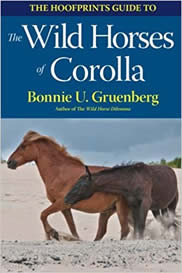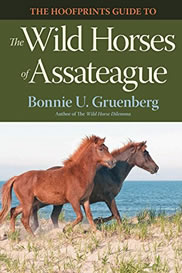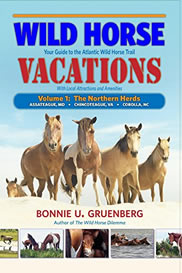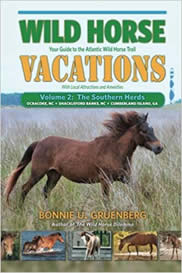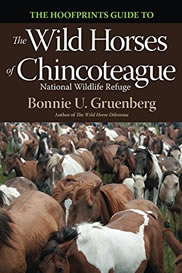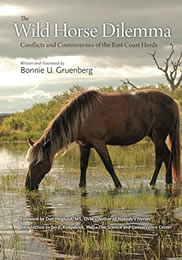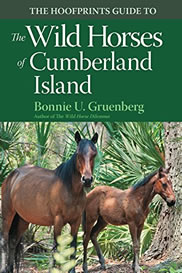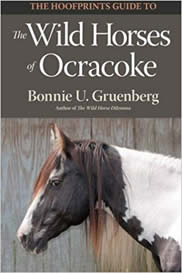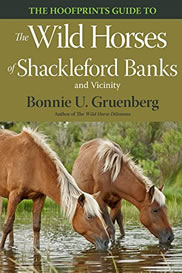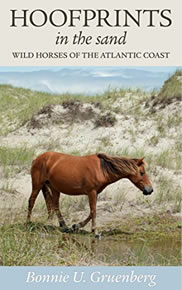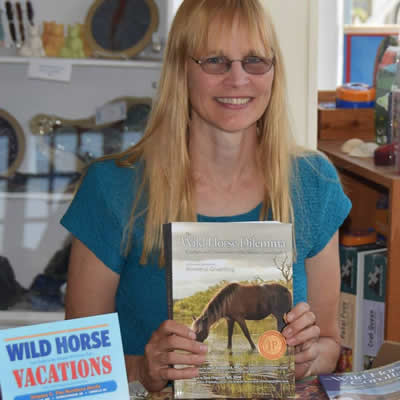 |
|---|
|
When I was a girl, I relished Marguerite Henry’s Misty books. Later, in the 1990’s, I was amazed to learn that not only did horses still run free on Assateague, but also that there were thriving herds on barrier islands all along the Atlantic coast. I have been fascinated by horses for as long as I can remember. I was intrigued by the idea that free-roaming horses could persist for hundreds of years so close to the major population centers of the East Coast. When I was young, I broke the legs off all my plastic Breyer horses in a desperate attempt to ride them. Yearning for contact with horses, I read every horse book in the library and wrote innumerable stories about girls and their mounts. I started taking lessons at age 10. When I was 14, I was hired by a trail riding stable exchanging chores for riding privileges. I practically lived at the barn, and eventually bought, trained, and maintained my first horse, Cameo, who was my companion though most of my teen years. I have owned and worked with many horses since then. I have two horses, Adagio and Andante, on our Lancaster County farmette. 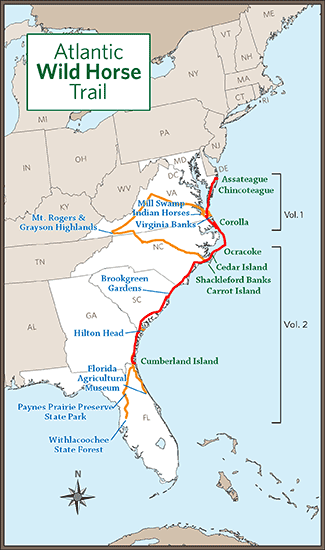
Each island herd is managed uniquely: • Assateague Island National Seashore, MD The 80-odd member herd is managed largely hands-off (like other wildlife) and is kept at a population level that minimizes damage to native species. Each mare is given the opportunity to reproduce, then is maintained on immunocontraceptive birth control for the rest of her life. The mares are literally vaccinated against pregnancy via dart gun with porcine zona pellucida (PZP) derived from pig ovaries. Freed from the stress of repeated pregnancies and nursing, contracepted mares live much longer than previous generations, with many individuals surpassing 30 years in age. More Info • Chincoteague National Wildlife Refuge, Assateague Island, Virginia The world-famous Chincoteague Ponies are technically owned by the Chincoteague Volunteer Fire Company. The ponies have probably been on the island since the late 1600’s, but in 1943, the US Fish and Wildlife Service established a 14,000-acre wildlife preserve on the Virginia end of Assateague. The fire department is permitted to graze up to 150 adult ponies and their offspring within two fenced compartments on the refuge. The fire company conducts round-ups three times per year and provides supplementary feed and veterinary care as needed. Every July, the fire company swims the ponies across the channel to the neighboring island of Chincoteague, where most of the year’s foals are sold to raise funds. Chincoteague ponies live up to 20 years in the wild, longer in domesticity. More Info • Corolla, NC The Corolla Wild Horse Fund, the non-profit agency that manages the herd, strikes a balance between preserving the heritage of the rare Banker breed and complying with imposed population limits. The organization brought in a stallion from the Cedar Island herd when genetic diversity became critically low in the herd. Immunocontraception is used to limit reproduction when the herd becomes too large. More Info
The horses of Ocracoke are no longer wild, but a small group remains as a representative of the thousands horses that ran the length of North Carolina’s Outer Banks from perhaps the 1600s through 1935. The National Park Service decides which horses to breed and when to breed them. Horses from nearby Shackleford Banks have been bred into the group for genetic diversity. More Info • Shackleford Banks, Cape Hatteras National Seashore The National Park Service carefully monitors the bloodlines of the wild horses of Shackleford Banks. Horses of well-represented bloodlines (that is, horses with many close relatives on the island) are more likely to be contracepted with the PZP vaccine. Horses from lines with few individuals on the island are given the opportunity to reproduce. The goal is to maintain optimal genetic diversity without bringing in outside horses. The NPS also removes individual horses from the island and puts them up for adoption. More Info • Rachel Carson Estuarine Reserve, Beaufort, NC The Fish and Wildlife Service maintains a small group using the PZP immunocontraceptive vaccine. More Info • Cedar Island, NC Cedar Island has a privately-owned wild horse refuge for historically significant Banker horses. Managers geld certain stallions to limit the population. • Cumberland Island National Seashore Cumberland Island has no horse management plan in place, mostly because of political conflicts. As a result, the population expands when rains bring rich, lush grasses, and experiences die-offs during drought. When the population expands beyond that which the island can support, the horses become emaciated, develop high parasite loads, and die at a higher rate, especially the very young. Horse overpopulation limits the forage and habitat available to native species on the island and causes dramatic ecologic imbalance. Horses on Cumberland island do not usually live more than 9 or 10 years. Yes! The genes of all the Atlantic coast herds show Spanish descent in genes, conformation or both. The real question is how they inherited their Spanish ancestry. In colonial times, horses were not categorized as breeds, but rather types or families grouped primarily by ability, usefulness, and individual accomplishment. The earliest farm animals in the English colonies of North America were probably Spanish livestock bought (or, by some accounts, stolen) from the Spanish ranches in the Caribbean. Horses were shipped to and from the British colonies from the early 1600s. Later, affluent breeders imported fine Spanish, English, Dutch, Irish, and French horses to the colonies. Many American breeds have Spanish heritage and derive from a relatively small gene pool. In colonial times, horses and other animals were released to free-range on the mainland, and by the 1700’s there were large herds of free-roaming horses ranging from New England through South Carolina. Eventually legislation demanded that livestock must be fenced and then imposed a tax on fences. Farmers quickly realized that if they free-ranged their livestock on barrier islands, they were contained by sea and sound, and fences were unnecessary. Stock raising was well established on many of the barrier islands of the Atlantic coast by the late 1600s. The fact that many of these small islands still bear the names Horse Island, Hog Island, and Sheep Island attests to this historic practice. By the mid-1700s, great numbers of untended Spanish horses roamed the Southeast, the descendants of Jennets introduced by Spanish explorers, probably after 1580. The first Europeans to settle the Carolina mountains found large numbers of wild horses roaming the open forests. Native American tribes, both Western and Eastern, acquired Spanish horses by trading with or stealing from European settlers or by capturing feral animals. These horses averaged just under 13.2 hands, and many were gaited—able to amble, pace, trot, and canter. They were surefooted, very fast, and had legendary endurance. Until the mid-18th century, wealthy planters typically invested in expensive pacers and racing horses, while poor subsistence farmers acquired Spanish ponies passed from Native Americans in the south and west to traders in Virginia and Carolina, as well as Narragansett Pacers and light European saddle horses. When they placed their stock on the barrier islands to graze, they became the basis of free roaming herds that in some cases persisted for hundreds of years. • Assateague Island The original free-roaming horses of Assateague Island were much like the Carolina Bankers and Marsh Tackies – largely derived from Colonial Spanish ancestry. Per historical accounts, in the 1800s they were solid-colored—bays, blacks, and sorrels—about thirteen hands high, uniform in shape, beautifully formed with remarkably long tails and manes, and very fleet. Shetland ponies were introduced in the 1920s to give pinto coloration, and through the 1900s other breeds were introduced including Morgans, Welsh Ponies, Arabians, Mustangs, Quarter Horses and possibly a Thoroughbred. The herd on the Maryland portion of Assateague has had no additions since it was designated a National Seashore in 1965. The Virginia herd has recently been infused with Arabian bloodlines. • Carolinas The horses of the North Carolina coast—Corolla, Shackleford Banks, Carrot Island, and Ocracoke—have more genetically in common with one another than with other breeds. Their genes and conformation show Spanish ancestry, but do not clarify just what that ancestry was or when and how ancestors arrived on the islands. Shared ancestry could mean that they descended from a single population that was placed on the island or arrived by shipwreck. Conversely, it could indicate that each herd originated 4 from horses on the nearby mainland that were then of similar type and breeding. The Carolina Banker Horse and the Marsh Tacky represent a critically endangered strain of perhaps the oldest surviving American horse breed, the Colonial Spanish Horse. • Cumberland Island In the 1800s, free-roaming Cumberland Horses were considered Marsh Tackies and might have carried a high proportion of Colonial Spanish blood. They were small in stature and had the reputation of being exceptionally strong and rugged. In 1881, Thomas Carnegie purchased the Stafford and Dungeness plantations and proceeded to improve the free-roaming herds by releasing Appaloosas, Tennessee Walking Horses, Thoroughbreds, and even retired circus horses. Over the years, the Carnegies released many other horses, including a white stallion from the stud farm of Czar Nicholas II, a train-car load of mustang mares from Arizona, and pureblooded Arabians. A horseman might call the horses north of Cumberland Island ponies, because they stand less than 14.2 hands. However, there are genetic distinctions between horses and ponies, and genetically the horses of the Atlantic islands are horses, not ponies. The Assateague herd has some Shetland Pony lineage from outcrossing in the 1920s. The Atlantic costal islands were used for grazing livestock for centuries, including Assateague and the Carolina Banks. However, shipwrecks may have also contributed individuals to the herds. Trade flourished from the earliest days of the North American colonies, and many of the ships sailing the Atlantic carried horses. Wrecks were commonplace and poorly documented, and storms often swept horses off the decks even when the ships remained intact. Many of these horses would have been drowned by violent stormy waves, but some might have survived to procreate. Any genes contributed to the herds by shipwreck survivors would have been very similar to those of the horses that safely arrived by other means. The horses traveling along Atlantic shipping routes were the same horses found in the colonies: Spanish Jennets; English, Dutch, Irish, and French horses; and the horses developed in the colonies through the interbreeding of these types. Disagreement smolders between those who regard the feral horse as an exotic pest and those who regard it as a cultural and historical icon. Some truly believe that free-roaming horses are native wildlife and that putting them back on the North American landscape constitutes a restoration of the natural order, the righting of a wrong perpetrated by prehistoric people who probably contributed to their extinction. Others see them as an invasive threat to native wildlife and valuable ranchland and seek to decrease or eliminate free-roaming horses. Emotions cloud facts when horses are involved, and stakeholders on both sides argue their points fervently. This argument is not only biological, but also cultural, economic, and political. When large numbers regard wild horses as wildlife, lawmakers and others are inclined to grant them protection. When large numbers label them exotic, laws exclude them, and public opinion supports their removal. Nuances of terminology affect management policies and influence the destiny of these herds. Barrier islands typically have natural high ground near the sound side, and these low hills are typically anchored by sturdy maritime forest untouched by overwash and storm surge. Horses can sense the approach of violent storms and gather in the safety of the sturdy oaks until the storm has passed. Man-made barns may blow down, but the forests persist. It is uncommon for a herd to suffer significant losses from storms, even large hurricanes. This is why the herds have persisted for centuries without help from humans. Barrier island horses graze preferentially on saltmarsh cordgrass, Spartina alterniflora, but enjoy a varied diet including American beachgrass, American three-square rush, phragmites reeds, saltmeadow cordgrass, sandburs, thistles, rose hips, crab apples, sea lettuce, greenbrier and even poison ivy! In the winter, bayberry and elder twigs and branches become important food sources for Assateague horses. Horses will drink from freshwater ponds and vernal pools if they are available. If no water is available, the Shackleford Banks and Rachel Carson Estuarine Reserve horses make their own water holes by digging in the sand with their hooves until they reach the water table. The barrier islands of the East Coast and many nearby areas are made mostly of sand surrounded and permeated by salt or brackish water. Rainfall seeps into the sand, and a lens-shaped body of freshwater develops and floats atop the denser saltwater, often extending deep below sea level. By digging, horses can dig to find fresh water on an island that has no permanent fresh water source. To access the water table, the horses sometimes dig so deep that only their rumps are visible as they drink from the pool. Freshwater can be slow to seep into these depressions, and pony herds may spend long periods near them to ensure that each herd member gets enough. Horses return to these same holes for as long as they continue to produce, enlarging them with every visit. On the Virginia end of Assateague, the Chincoteague Volunteer Fire Company provides fresh water and hay as needed. Assateague, MD: 82 horses in 2018 Merriam-Webster’s Collegiate Dictionary defines feral as "having escaped from domestication and become wild.” The U.S. National Park Service defines native species as “all species that have occurred or now occur as a result of natural processes,” and defines exotic species as those that have arrived “as the result of deliberate or accidental human activities”. But horses evolved on the North American continent and persisted for millions of years until about 10,000 years ago. The end of the Pleistocene saw the extinction of many large north American mammals, including mammoths, mastodons, and horses. It is unclear why these previously thriving species vanished so quickly, but we do know that these losses largely coincided with both major climate change and the arrival of humans. Genetic analysis of Pleistocene fossils has demonstrated that the E. caballus repatriated by European explorers after a comparatively short absence is biologically identical to the ancient horse that roamed the ancestral grasslands. For this reason, some scientists view our free-roaming horses as a native species which has been reintroduced to its native ecosystem.
Twelve, not counting the smaller e-books. 10 of them are about the horses of the Atlantic Coast barrier islands. I am a certified nurse-midwife by profession and write childbirth emergency books as well. The American public cares passionately about the fate of wild horses, and the majority of us want to see them remain wild and independent. Paradoxically, we must manage wild horses to keep them free. We must apply scientific management principles to ensure that our wild herds remain healthy and in harmony with their ecosystems. To balance environmental concerns, politics, public sentiment, and the needs of the horses themselves, wild-horse management policy should be determined by multidisciplinary panels comprised of land managers, scientists, horse advocates, ranchers, politicians, and other stakeholders. When visiting the herds, each of us is responsible for keeping the wildness in the horses by keeping a respectful distance and avoiding the temptation to pet them or interact with them. We are guardians of the herds. The quality of their continued existence depends on the choices we make on their behalf—and anything we do or do not do will profoundly affect their destiny. For more information, please visit Bonnie's websites: Visit Bonnie's website Interview by: Nicole Reggia |

 INTERVIEW with Bonnie Gruenberg
INTERVIEW with Bonnie Gruenberg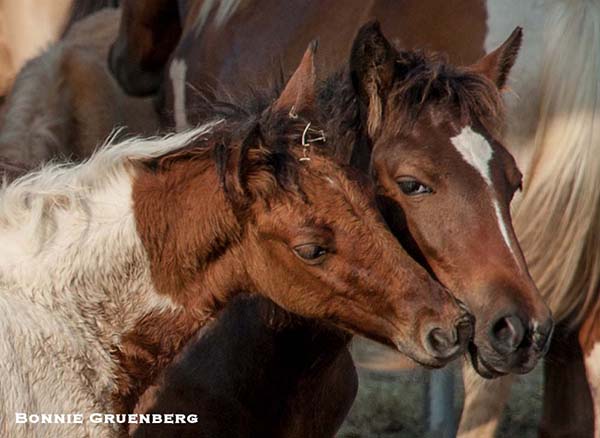
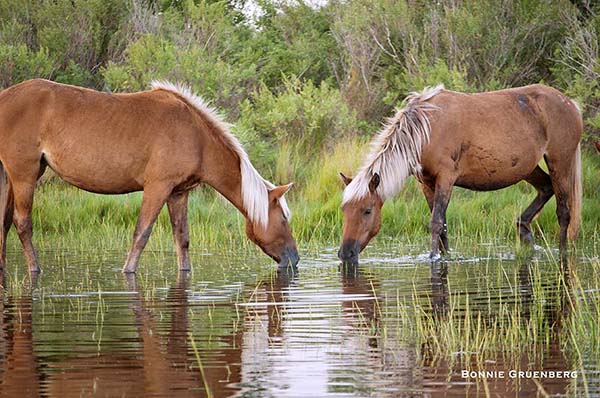
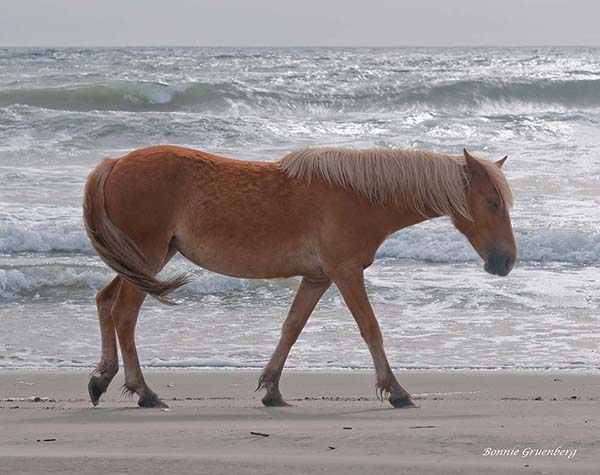
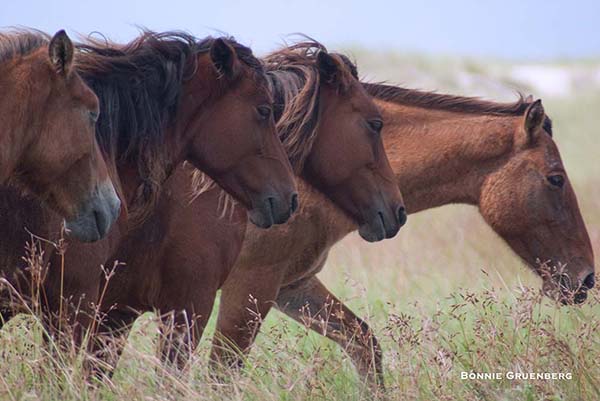
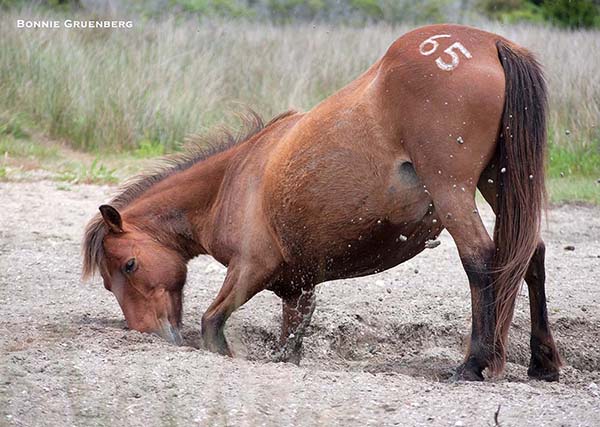
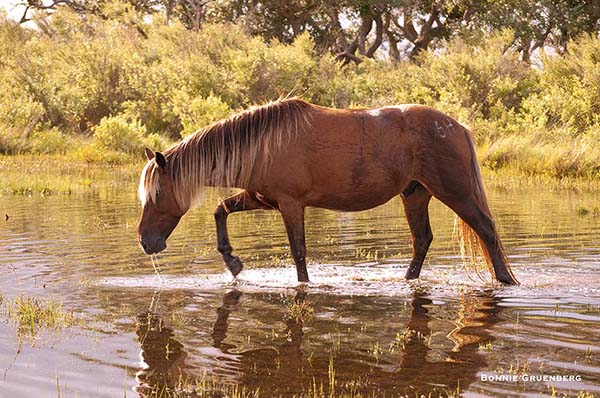
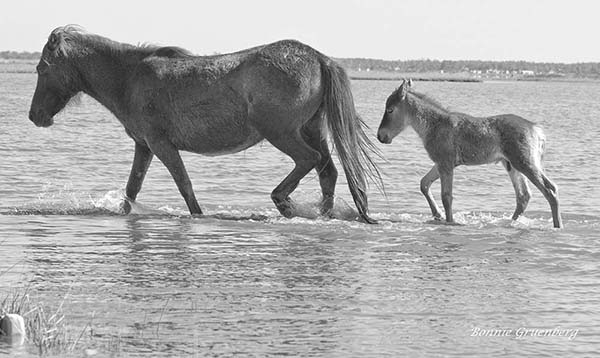
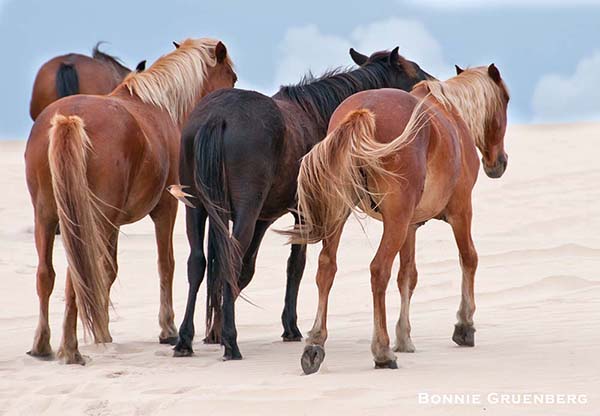
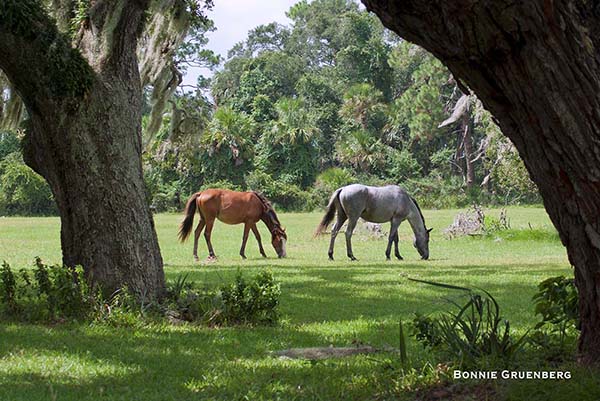
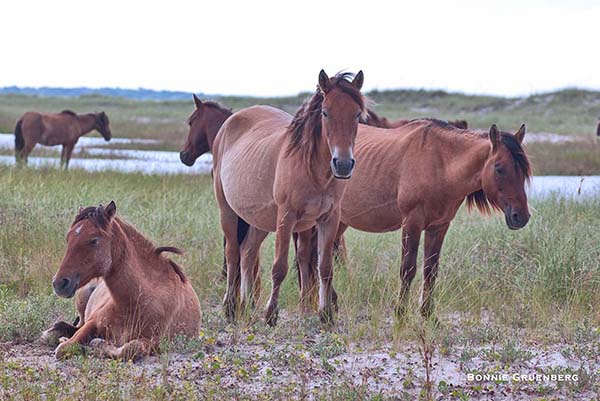
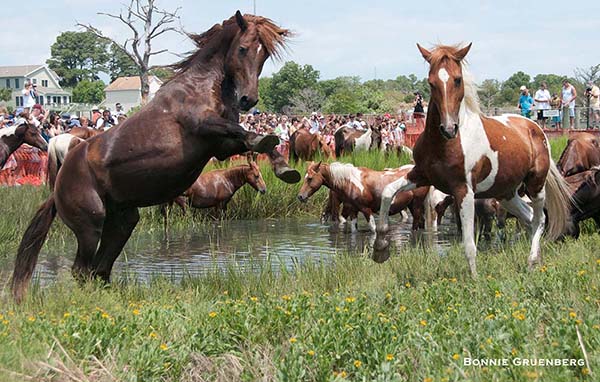
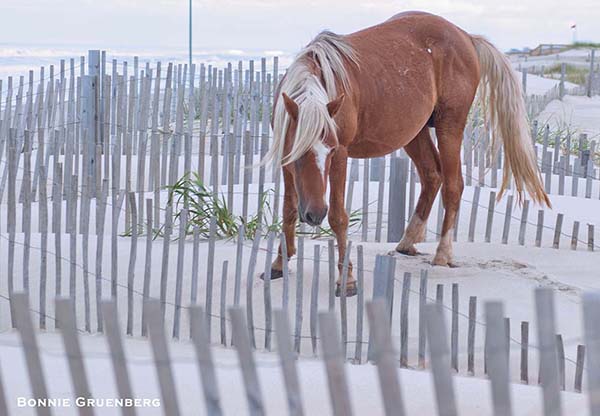
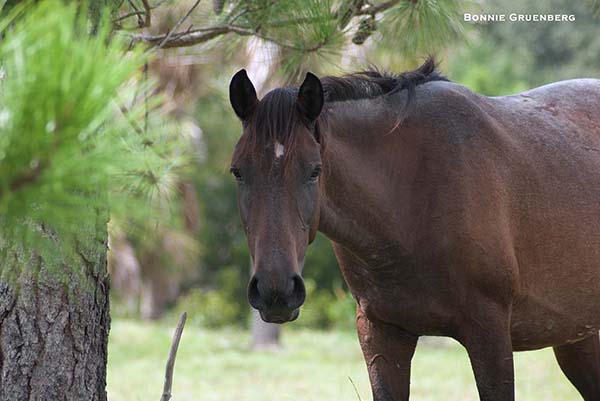
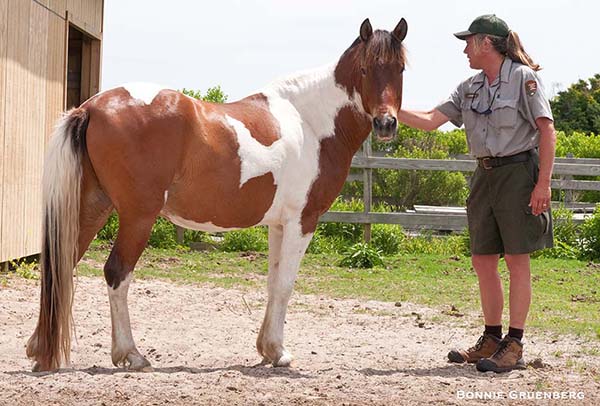
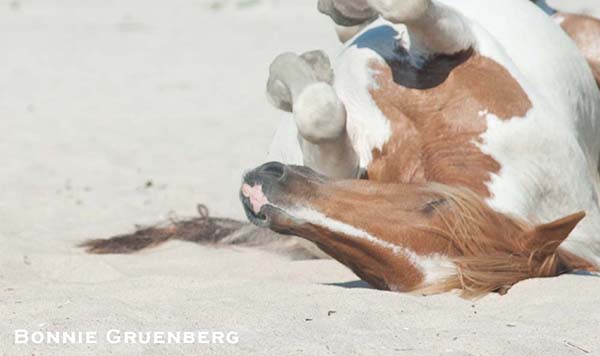
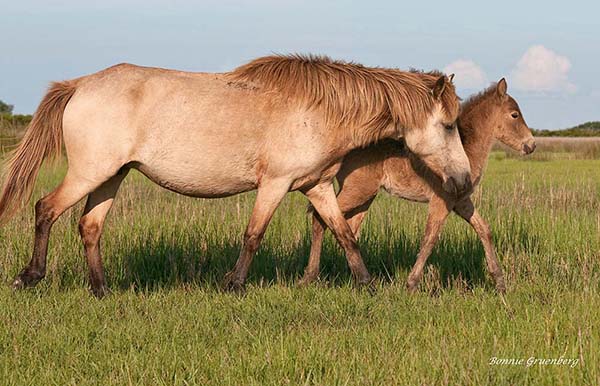
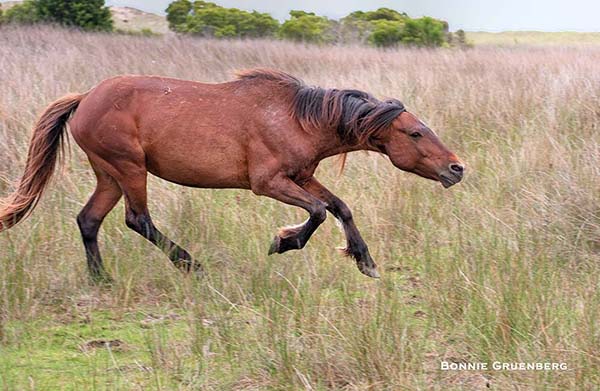
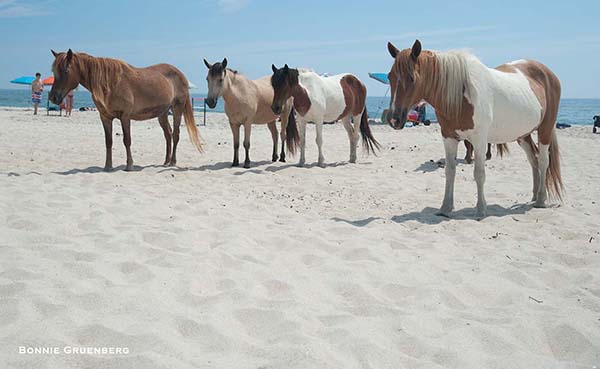
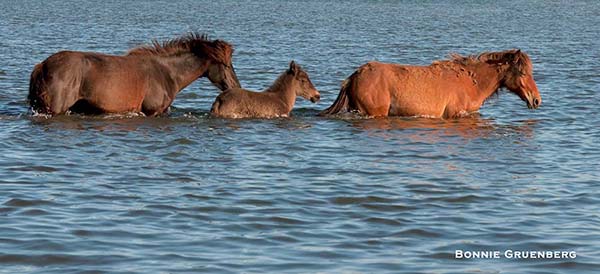
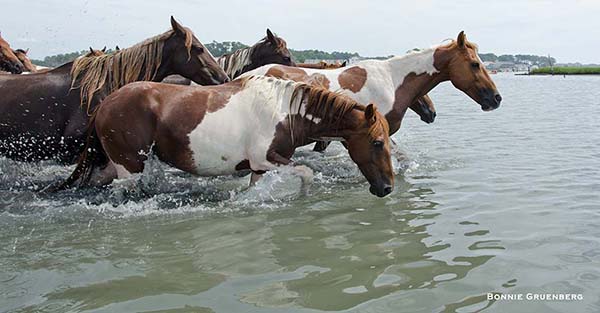
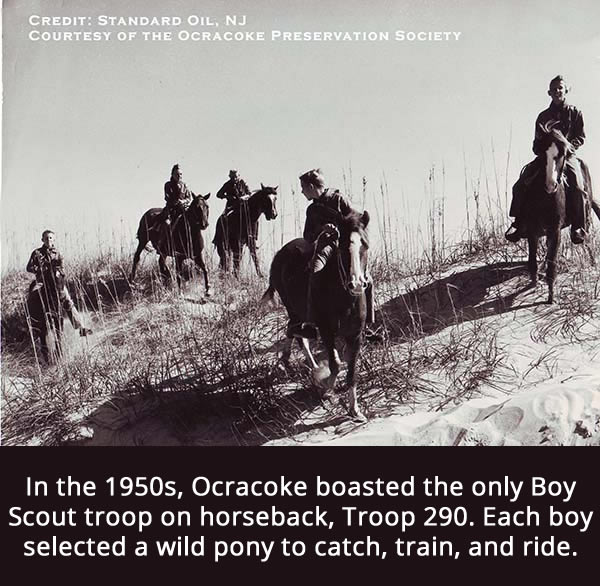 • Ocracoke Island/ Cape Hatteras National Seashore
• Ocracoke Island/ Cape Hatteras National Seashore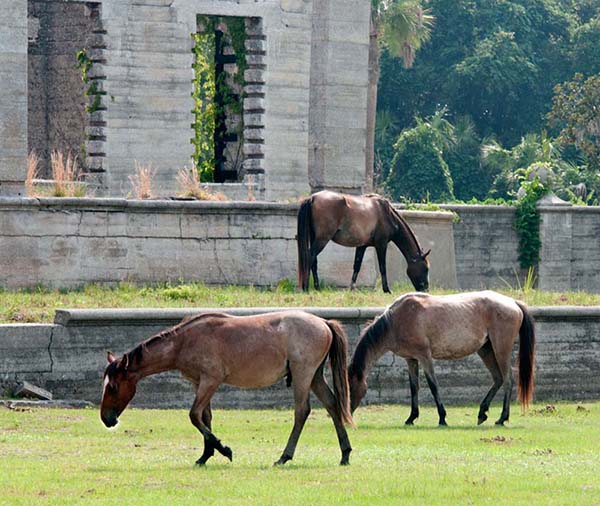
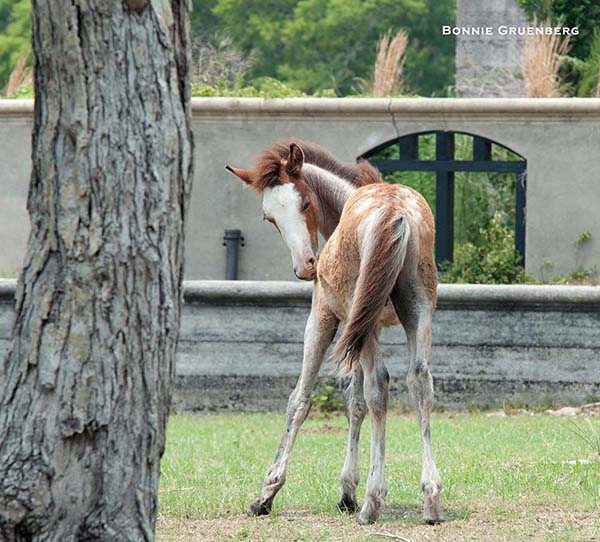
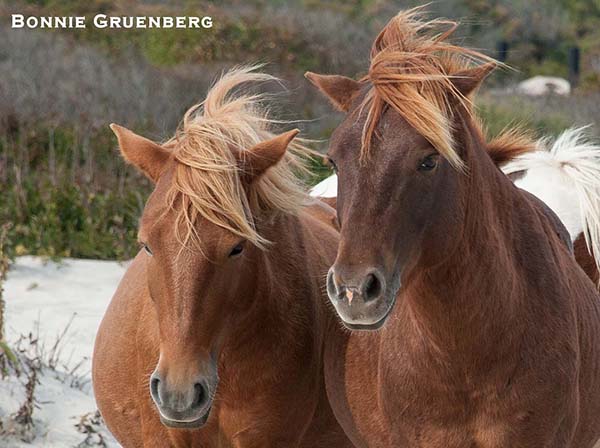
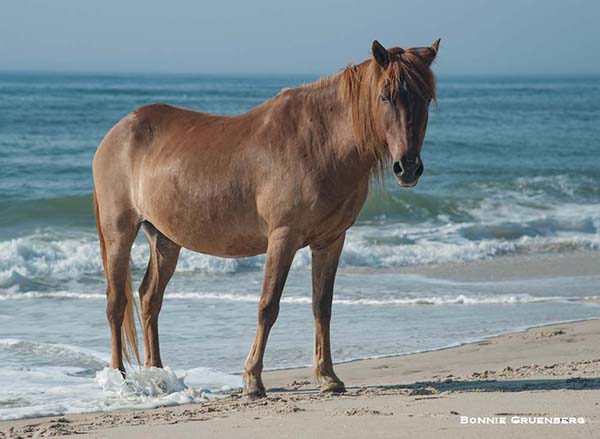
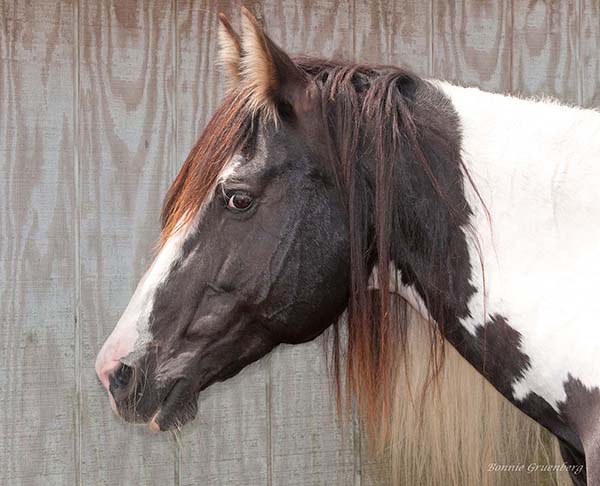
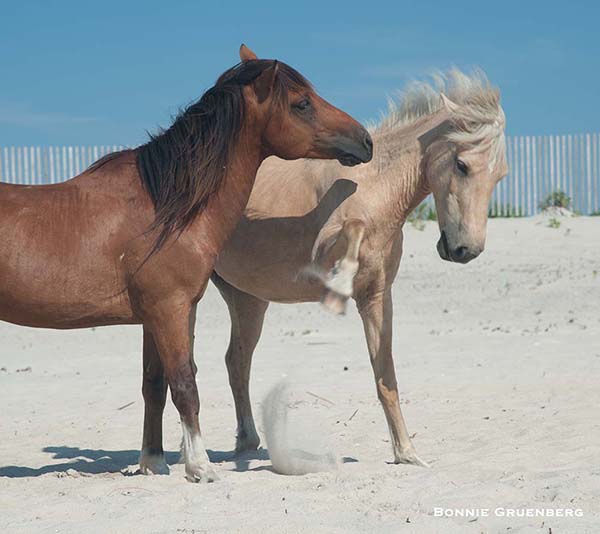
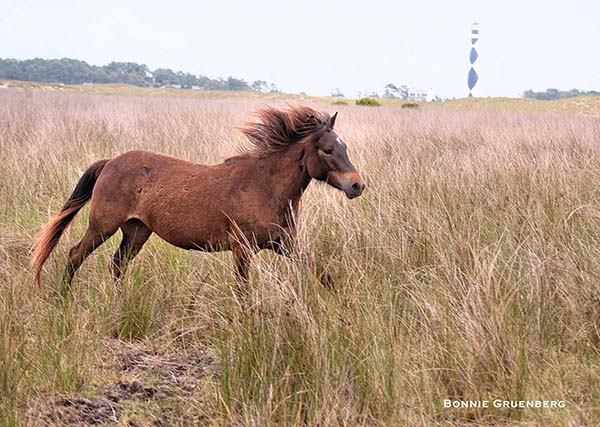
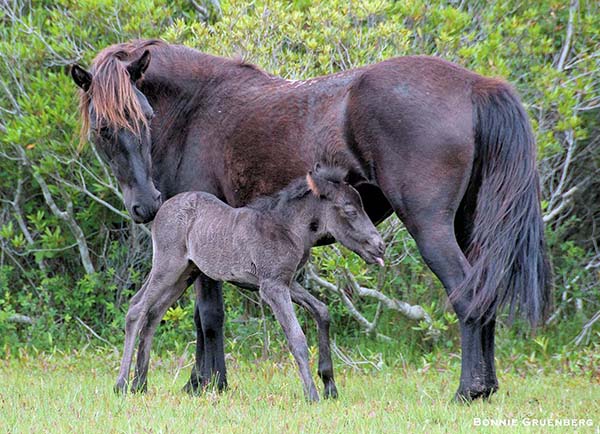
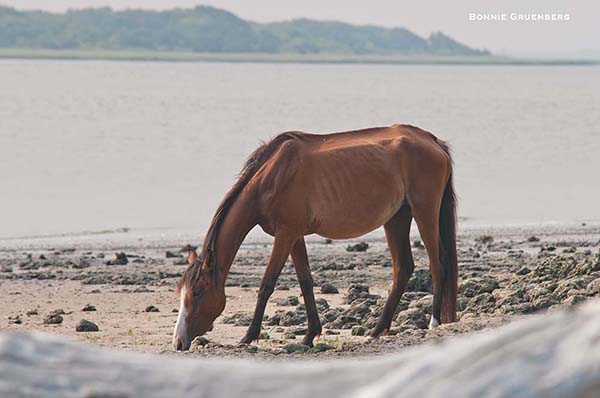
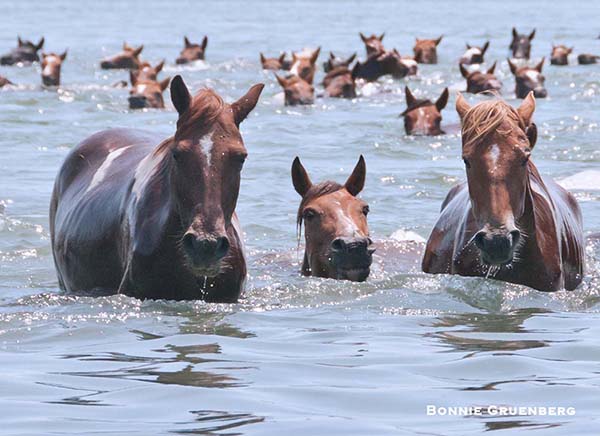
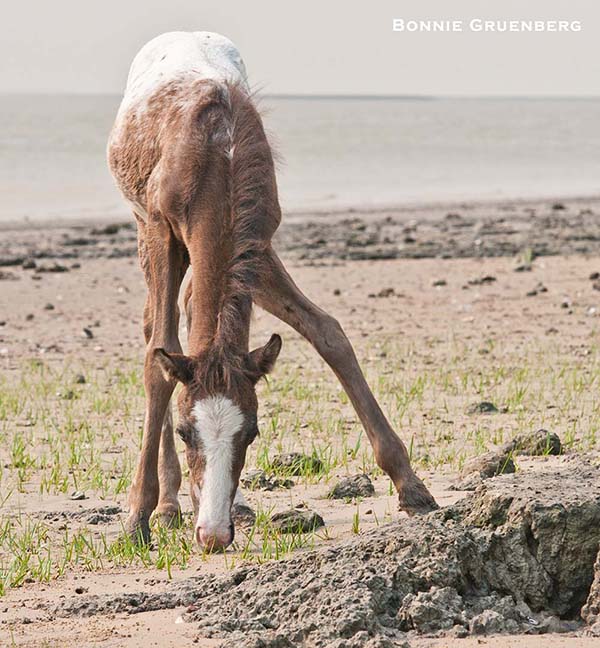
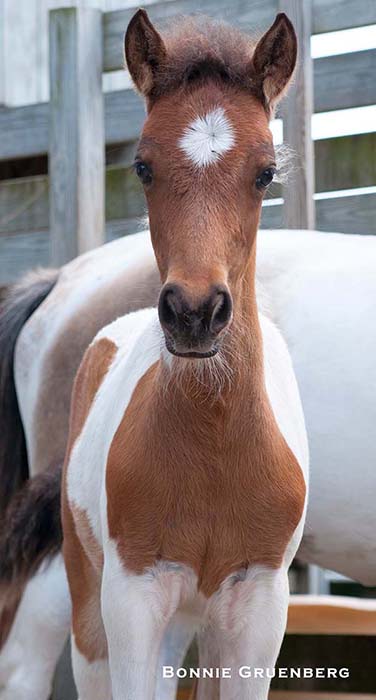
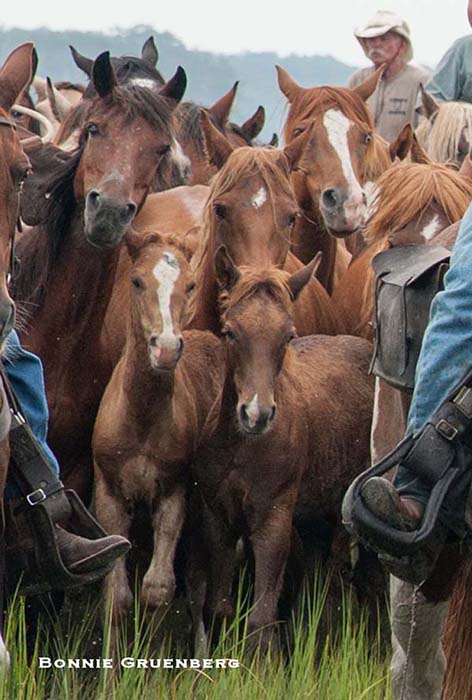
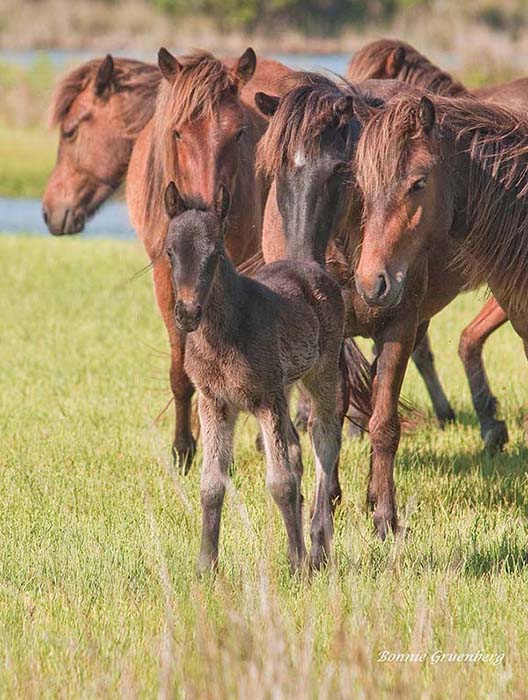
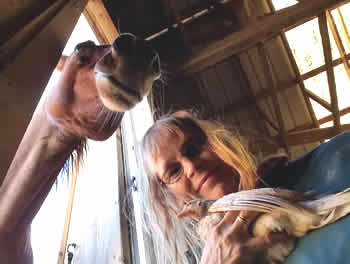 When I first visited Cape Hatteras, North Carolina, in 1993, I was surprised to find that wild horses lived on several nearby islands and had once ranged along much of the Atlantic coast. They made their first hoofprints there not long after the arrival of early European settlers, and in time they ran free on innumerable North American islands from the Caribbean to Canada. I learned that small herds remained on the coast of Virginia, North Carolina, Maryland, and Georgia; on Sable Island, off Nova Scotia, Canada; and on Great Abaco Island in the Bahamas. I looked for books about them, but credible information was scarce. Newspaper and magazine articles often appeared incorrect or fanciful, drawn from the statements of misinformed people, or based on superficial research. Frustrated by the lack of solid information, I set about writing an accurate, comprehensive book useful to other interested people. The result was my first book, Hoofprints in the Sand.
When I first visited Cape Hatteras, North Carolina, in 1993, I was surprised to find that wild horses lived on several nearby islands and had once ranged along much of the Atlantic coast. They made their first hoofprints there not long after the arrival of early European settlers, and in time they ran free on innumerable North American islands from the Caribbean to Canada. I learned that small herds remained on the coast of Virginia, North Carolina, Maryland, and Georgia; on Sable Island, off Nova Scotia, Canada; and on Great Abaco Island in the Bahamas. I looked for books about them, but credible information was scarce. Newspaper and magazine articles often appeared incorrect or fanciful, drawn from the statements of misinformed people, or based on superficial research. Frustrated by the lack of solid information, I set about writing an accurate, comprehensive book useful to other interested people. The result was my first book, Hoofprints in the Sand.